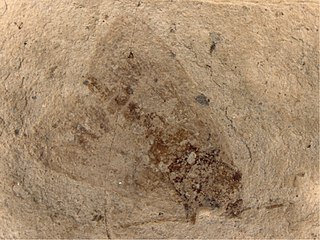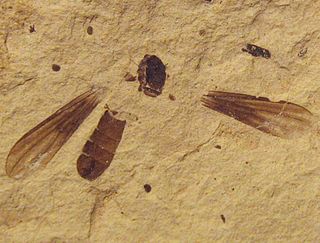
The Cixiidae are a family of fulgoroid insects, one of many families commonly known as planthoppers, distributed worldwide and comprising more than 2,000 species from over 150 genera. The genera are placed into three subfamilies, Borystheninae, Bothriocerinae and Cixiinae with sixteen tribes currently accepted in Cixiinae.

Dictyopharidae is a family of planthoppers, related to the Fulgoridae. The family comprises nearly 760 species in more than 150 genera which are grouped into two subfamilies, Dictyopharinae and Orgeriinae.

Archiinocellia is an extinct genus of snakefly in the family Raphidiidae known from Eocene fossils found in western North America. The genus contains two species, the older Archiinocellia oligoneura and the younger Archiinocellia protomaculata. The type species is of Ypresian age and from the Horsefly Beds of British Columbia, while the younger species from the Lutetian Green River Formation in Colorado. Archiinocellia protomaculata was first described as Agulla protomaculata, and later moved to Archiinocellia.

Allorapisma is an extinct genus of lacewing in the moth lacewings family Ithonidae. The genus is solely known from two Eocene fossils found in North America. At the time of description the genus was composed of a single species, Allorapisma chuorum.
Glisachaemus is an extinct monotypic genus of planthopper in the Cixiidae subfamily Cixiinae and at present, it contains the single species Glisachaemus jonasdamzeni. The genus is solely known from the Early Eocene Baltic amber deposits in the Baltic Sea region of Europe.
Tainosia is an extinct monotypic genus of planthopper in the Nogodinidae subfamily Nogodininae and at present, it contains the single species Tainosia quisqueyae. The genus is solely known from the early Miocene, Burdigalian stage, Dominican amber deposits on the island of Hispaniola.

Paleolepidopterites is a collective genus of fossil moths which can not be placed in any defined family. The included species were formerly placed in the leaf-roller family Tortricidae and are known from fossils found in Russia and the United States. The collective genus contains three species: Paleolepidopterites destructus, Paleolepidopterites florissantanus, and Paleolepidopterites sadilenkoi, formerly placed within the genera Tortrix and Tortricites respectively. The three species were formally redescribed and moved to the new collective genus by Heikkilä et al (2018).
Epiborkhausenites is an extinct genus of moth in the concealer moth family Oecophoridae and containing a single species Epiborkhausenites obscurotrimaculatus. The species is known only from Middle Eocene, Bartonian stage, Baltic amber deposits near the town of Palanga in Lithuania.
Bohemiatupus is an extinct genus of griffenfly in the family Meganeuridae and containing a single species Bohemiatupus elegans. The species is known only from the Late Carboniferous, Bolsovian stage, Kladno Formation near the village of Radnice in the Radnice Basin, Czech Republic.
Mongolbittacus is an extinct genus of hangingfly in the family Bittacidae and containing a single species Mongolbittacus daohugoensis. The species is known only from the Middle Jurassic Jiulongshan Formation, part of the Daohugou Beds, near the village of Daohugou in Ningcheng County, northeastern China.
Emiliana is an extinct genus of planthopper in the Tropiduchidae tribe Emilianini and containing the single species Emiliana alexandri. The species is known only from the Middle Eocene Parachute Member, part of the Green River Formation, in the Piceance Creek Basin, Garfield County, northwestern Colorado, USA.

Nogodinidae is a family of planthoppers. They have membranous wings with delicate venation and can be confused with members of other Fulgoroid families such as the Issidae and Tropiduchidae. Some authors treat it as a subfamily of the Issidae. Some of their key features are a frons ("face") that is longer than wide and a reticulate wing venation. They are less than 2 cm long. The antenna arises well below the eye, has the base clubbed and flagellum unsegmented. The lateral ocelli are outside the margins of the face. The face has carinae on the edge. On the hind leg, the second tarsal segment has an apical spine arising from it. The tibia of the hind leg also has spines towards the tip. An important family character is found in the shape of the male genital structure, a style that is longer than broad. Most members of this family are forest species.

Parastylotermes is an extinct genus of termite in the Isoptera family Stylotermitidae known from North America, Europe, and India. The genus contains five described species, Parastylotermes calico, Parastylotermes frazieri, Parastylotermes krishnai, Parastylotermes robustus, and Parastylotermes washingtonensis.

Metanephrocerus is an extinct genus of big-headed flies in the dipteran subfamily Protonephrocerinae, for which it is one of only two genera. The genus contains four described species, Metanephrocerus belgardeae, M. collini, M. groehni, and M. hoffeinsorum. Metanephrocerus is known from a group of Middle Eocene fossils which were found in Europe and a single early Eocene fossil from North America.

Elektrithone is an extinct genus of lacewing in the moth lacewings family Ithonidae. The genus is solely known from an Eocene fossil forewing found in Europe. At the times of description the genus was composed of a single species, Elektrithone expectata.

Casaleia is an extinct genus of ants in the formicid subfamily Amblyoponinae described by Pagliano & Scaramozzino in 1990 from fossils found in Europe. The genus contains four species dating from the Eocene to Miocene, Casaleia eocenica, Casaleia inversa, Casaleia longiventris, Casaleia orientalis.

Yantaromyrmex is an extinct genus of ants first described in 2013. Members of this genus are in the subfamily Dolichoderinae of the family Formicidae, known from Middle Eocene to Early Oligocene fossils found in Europe. The genus currently contains five described species, Y. constrictus, Y. geinitzi, Y. intermedius, Y. mayrianum and Y. samlandicus. The first specimens were collected in 1868 and studied by Austrian entomologist Gustav Mayr, who originally placed the fossils in other ant genera until the fossils were reviewed and subsequently placed into their own genus. These ants are small, measuring from 4 to 6 mm in length and can be characterized by their trapezoidal shaped head-capsules and oval compound eyes that are located slightly to the rear of the capsules midpoint, with no known ocelli present.
Principiala is an extinct genus of lacewing in the moth lacewings family Ithonidae. The genus is known from Cretaceous fossils found in South America, Europe, and possibly Asia. The genus is composed of two species, the type species Principiala incerta, and Principiala rudgwickensis.

Protopone is an extinct genus of ants in the formicid subfamily Ponerinae described from fossils found in Europe and Asia. There are seven described species placed into the genus, Protopone? dubia, Protopone germanica, Protopone magna, Protopone oculata, Protopone primigena, Protopone sepulta, and Protopone vetula. Protopone is one several Lutetian Ponerinae genera.

Alicodoxa is an extinct genus of planthopper in the fulgoroid family Dictyopharidae. The genus contains a single described species, Alicodoxa rasnitsyni and is known from several Late Eocene fossils which were found in Europe.













